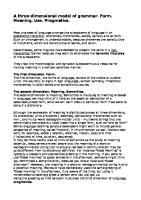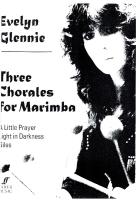Three Dimensional Grammar Framework [PDF]
When it comes to grammar and grammar instruction, there are three-dimensional framework you need to constantly keep in v
44 1 92KB
Papiere empfehlen
![Three Dimensional Grammar Framework [PDF]](https://vdoc.tips/img/200x200/three-dimensional-grammar-framework.jpg)
- Author / Uploaded
- AIREN FERRER
Datei wird geladen, bitte warten...
Zitiervorschau
When it comes to grammar and grammar instruction, there are three-dimensional framework you need to constantly keep in view – those are meaning, form and use.
First, I just want to define meaning, form and use in general.
Here you see the three-grammar teaching tool.
1. MEANING - Semantics - What the grammar communicates
The first is one is meaning – semantics, which is a fancy word for meaning, but what we're talking about here is what the grammar communicates. Each grammar tense and grammar point have its own reason for existing. It conveys information in and of itself.
2. FORM - Grammar charts or formulas - Pronunciation
When we talk regarding form, we're referring to how something is written or spoken. So we'll start with tools like grammar charts and formulas. The infinitive form of the verb would be at the top of a grammar chart, followed by a list of all the conjugations and a formula - talk about how a sentence is produced. Furthermore, form includes how it is said, including pronunciation, which is especially significant for grammar tenses that use contractions, such as "I am running or I'm running."
3. USE - When/how used to communicate within a meaningful context
And then there's use, which is the bigger picture of how this communicatively employed inside a discourse, how and when we use this to communicate within a context, and while all three are vital, use will be the most difficult.
EXAMPLES:
“PRESENT SIMPLE”
1. MEANING - Repetitive actions or habits - Generalizations, facts and beliefs - Near future schedule events
I'd want to give you a few concrete examples to help you understand what we're talking about. Starting with the present simple, the purpose of this grammar tense is to convey repeated activities and existing habits. It can also convey general truths, facts, and beliefs, as well as upcoming events in the near future.
2. FORM - I/You/They/We + verb - He/She/It + verb + s
EXAMPLE:
I love banana. She writes a novel.
The form, as the name implies, is simple. Or the subject I, you, they and we, were going to use the base form of the verb. For the third person, he, she, it, as well as names, we’ll put the verbs plus S.
3. USE - Describe yourself (friend, family member and so on) - Personal habits: What do you do every morning/day/night? What is your favorites day of the week? Why?
EXAMPLE: On Saturdays, I get up and do things like drink my coffee in the morning and get outside in the sun with my family.
Now for some use ideas: how can we deliver this in a meaningful way and invite your students to communicate in a meaningful way? you are free to describe yourself. Create a short text or audio recording in which you explain yourself, a friend, or a family member, their behaviors, habits, and beliefs. You can talk about your personal habits. What do you do every morning, afternoon, and evening? Which day of the week is your favorite? I enjoy Saturdays if we communicate. On Saturdays, I get up and do things like this. You can use these to give a presentation and then ask the students to share information about themselves. This will be a terrific method to introduce some new verbs, and you can encourage them to do the same.
“PAST CONTINUOUS/PROGRESSIVE”
1. MEANING - Specific time as interruption EXAMPLE: Last night, I was sleeping.
- Past action interrupted (with past simple) EXAMPLE: When you called me, I was sleeping.
- Parallel past actions (two verbs in this tense) EXAMPLE: I was walking while I was talking on my phone.
Moving on to another.
This meaning communicates a precise moment as an interruption, such as at midnight last night when I was sleeping. You can also resume a previously paused action. Like, when you called, I was sleeping, so you'd use a past simple verb that interrupts ongoing action. Also, compare and contrast previous activities. Two things are happening at the same moment if you employed the two verbs in the same past continuous. EXAMPLE: I was walking while I was talking on my phone. 2. FORM - I/He/She/It + was + verb + -ing You/They/We + were + verb + -ing - Unlike with the present continuous, we don’t use contractions
EXAMPLE: He was playing basketball at the college tournament.
So, I, he, she, it, and this auxiliary helper verb were added to the verb -ing. You can also use you, the, they, and we'll use were plus verb and -ing. Now, unlike the present continuous, we do not need contractions when speaking this tense, which is significant.
3. USE - What were you doing at specific times yesterday? - A personal story (funny, sad, embarrassing, etc.) - Describe your best travel experience.
EXAMPLE: The sun was bright and I was swimming in the ocean
Now for some suggestions for this tense. It's about what you did at certain times yesterday. Different times of the day are discussed. When you share personal information or describe a hilarious, tragic, or embarrassing story about yourself, and
use multiple examples from the past continuous, a personal story is a terrific approach to engage pupils. You might also explain your favorite vacation. EX: The sun was bright and I was swimming in the ocean. Then, you know, you'd utilize those instances to emphasize the form and purpose.
“ADVERBS OF FREQUENCY”
1. MEANING - The frequency (or lack thereof) of actions/habits.
Adverbs of frequency are a non-tense-based grammar point. The meaning of these adverbs is basically the meaning of the individual adverbs, the frequency of actions and habits, or the absence thereof. We're dealing about words like never, rarely, often, sometimes, frequently, frequently, and always. So, the meaning here is essentially the meaning of those words, and in that way, this is more of a vocabulary focus, but we do need to pay attention to the form, which is more than just the spelling of those words. It's the order in which they're used in a sentence.
2. FORM - Pre- or post-position of sentence EXAMPLE: Often, I go to beach. I go to beach often.
- Position before verbs for simple verbs. EXAMPLE: I often go to the beach.
- Between auxiliary verbs and main verbs EXAMPLE: You should never give up. I am always jogging at 6AM.
So, there can be preposition or post position of the sentence, meaning it can be in the beginning or in the end. EX: Often, I go to beach. Or I go to beach often. It can also be positioned before the verbs like “I often go to the beach.” And it is important for verbs that have auxiliary helpers, verb tenses, you, they go between the helper verb and the main verb. EX: You should never give up. I am always jogging at 6AM.
3. USE - It’s the same in a present simple but with added information.
The ideas here are the same as in the present simple, but you can communicate these things with extra detail, such as how often you do these things, and it can also be used with the past simple and any grammar point.
CONCLUSION:
Some of you may be asking why I presented these foci in this order, beginning with meaning and ending with form and use. For some, it may seem more natural to begin with an emphasis on form, to first show those grammatical formulae or grammar charts, but there's a very significant reason I chose this order: we, as future English teachers, must aim to keep meaning in mind first before form and use throughout our lesson plans. To help our learners develop a sense on how language works , know the purpose and what we mean to become an effective communicator.
REFERENCE: Youtube.com. 2017. TEFL Grammar: Form vs Meaning vs Use. [online] Available at: https://www.youtube.com/watch?v=MlVBGQouvoA&t=1s [Accessed 11 May 2022].









